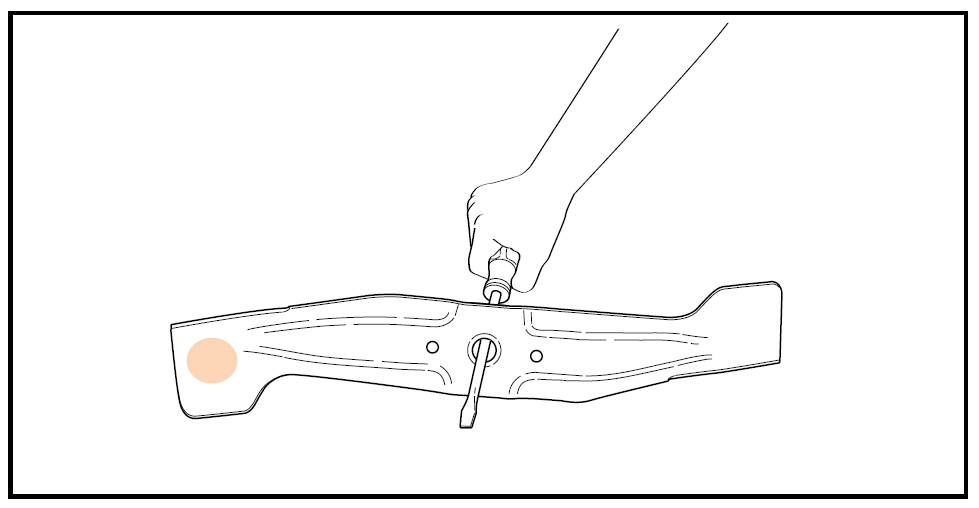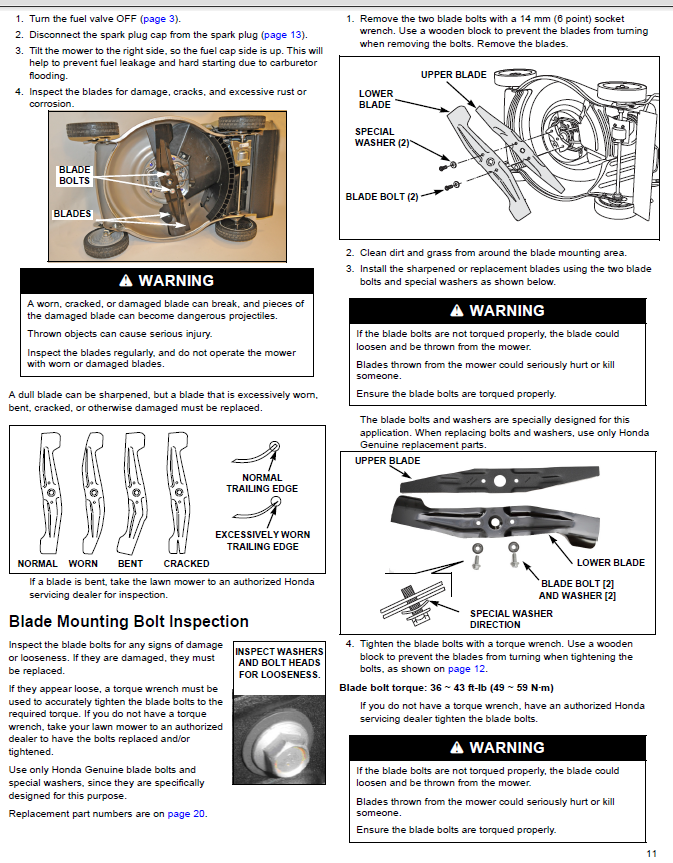You are using an out of date browser. It may not display this or other websites correctly.
You should upgrade or use an alternative browser.
You should upgrade or use an alternative browser.
Export thread
Honda Lawnmower: Sharpening the blades
#1

MowerMark
MowerMark
Have three questions about blade sharpening. I use a hand-held blade sharpener. Takes only 3-5 strokes and the blade renews.
1. Seems that it is recommended that one doesn't get them too sharp. How does one measure sharpness and how to judge how sharp they should be?
2. The top blade, the one closer to the belt, never seems to get as sharp as the lower blade, the one closest to the grass. Why are there two blades and is it okay for the top one to not be as sharp as the lower one?
3. I sharpen the blades myself because the local shop charges a whopping $16 to sharpen the blades. However, they also check the balance. My mower doesn't vibrate. Is it really important to check the balance after sharpening the blades?
1. Seems that it is recommended that one doesn't get them too sharp. How does one measure sharpness and how to judge how sharp they should be?
2. The top blade, the one closer to the belt, never seems to get as sharp as the lower blade, the one closest to the grass. Why are there two blades and is it okay for the top one to not be as sharp as the lower one?
3. I sharpen the blades myself because the local shop charges a whopping $16 to sharpen the blades. However, they also check the balance. My mower doesn't vibrate. Is it really important to check the balance after sharpening the blades?
#2

robert@honda
It is a relative term, "sharp" and with more experience mowing, sharpening, etc. you'll get a better idea what sharpness works best on your lawn yet minimizes wear on the blades. Dull blades will shear or tear the grass, rather than cut it, and too-sharp blades will wear down quickly.
The Honda blades have a unique jobs, so the blades are shaped and sharpened differently; as the blades spin across the tips of the grass, the lower blade cuts off a tip of grass that is anchored to the soil, and a microsecond later, the upper blade cuts that now floating tip of grass again. This produces very fine clippings, which mean the bag fills more evenly or the mulch created is more fine. It is my understanding the physics, airflow, etc. all are part of the engineering and design of the blade shape, including the angle of the cutting edges. The larger, bottom blade has more surface area to generator more airflow to keep the clippings circulating, allowing the upper blade to cut and cut and cut again until the bits are so small they can fall down into the lawn when mulching.
The blades are a heavy mass being rotated by the engine. Having them accurately balanced will significantly reduce vibrations caused from an out-of-balance blade. Less vibration on the mower means bolts won't come loose, parts won't fall off, and less irritation to the operator's hands. The engine will, in theory, have a longer service life the less external vibrations exerted on it. You can easily balance a mower blade with a round-shaft screwdriver placed in the center hole. If a blade side consistently drops, remove more blade material from that side. It won't take much.
robert@honda
Have three questions about blade sharpening. I use a hand-held blade sharpener. Takes only 3-5 strokes and the blade renews.
1. Seems that it is recommended that one doesn't get them too sharp. How does one measure sharpness and how to judge how sharp they should be?
It is a relative term, "sharp" and with more experience mowing, sharpening, etc. you'll get a better idea what sharpness works best on your lawn yet minimizes wear on the blades. Dull blades will shear or tear the grass, rather than cut it, and too-sharp blades will wear down quickly.
2. The top blade, the one closer to the belt, never seems to get as sharp as the lower blade, the one closest to the grass. Why are there two blades and is it okay for the top one to not be as sharp as the lower one?
The Honda blades have a unique jobs, so the blades are shaped and sharpened differently; as the blades spin across the tips of the grass, the lower blade cuts off a tip of grass that is anchored to the soil, and a microsecond later, the upper blade cuts that now floating tip of grass again. This produces very fine clippings, which mean the bag fills more evenly or the mulch created is more fine. It is my understanding the physics, airflow, etc. all are part of the engineering and design of the blade shape, including the angle of the cutting edges. The larger, bottom blade has more surface area to generator more airflow to keep the clippings circulating, allowing the upper blade to cut and cut and cut again until the bits are so small they can fall down into the lawn when mulching.
3. I sharpen the blades myself because the local shop charges a whopping $16 to sharpen the blades. However, they also check the balance. My mower doesn't vibrate. Is it really important to check the balance after sharpening the blades?
The blades are a heavy mass being rotated by the engine. Having them accurately balanced will significantly reduce vibrations caused from an out-of-balance blade. Less vibration on the mower means bolts won't come loose, parts won't fall off, and less irritation to the operator's hands. The engine will, in theory, have a longer service life the less external vibrations exerted on it. You can easily balance a mower blade with a round-shaft screwdriver placed in the center hole. If a blade side consistently drops, remove more blade material from that side. It won't take much.
#3

MowerMark
Thank you, Robert. Well-stated, except not certain about the balance test and orientation of the screwdriver and blade. Is there a video? A graphic?
Also, please post again that picture of proper blade placement for my model mower.
MowerMark
It is a relative term, "sharp" and with more experience mowing, sharpening, etc. you'll get a better idea what sharpness works best on your lawn yet minimizes wear on the blades. Dull blades will shear or tear the grass, rather than cut it, and too-sharp blades will wear down quickly.
The Honda blades have a unique jobs, so the blades are shaped and sharpened differently; as the blades spin across the tips of the grass, the lower blade cuts off a tip of grass that is anchored to the soil, and a microsecond later, the upper blade cuts that now floating tip of grass again. This produces very fine clippings, which mean the bag fills more evenly or the mulch created is more fine. It is my understanding the physics, airflow, etc. all are part of the engineering and design of the blade shape, including the angle of the cutting edges. The larger, bottom blade has more surface area to generator more airflow to keep the clippings circulating, allowing the upper blade to cut and cut and cut again until the bits are so small they can fall down into the lawn when mulching.
The blades are a heavy mass being rotated by the engine. Having them accurately balanced will significantly reduce vibrations caused from an out-of-balance blade. Less vibration on the mower means bolts won't come loose, parts won't fall off, and less irritation to the operator's hands. The engine will, in theory, have a longer service life the less external vibrations exerted on it. You can easily balance a mower blade with a round-shaft screwdriver placed in the center hole. If a blade side consistently drops, remove more blade material from that side. It won't take much.
Thank you, Robert. Well-stated, except not certain about the balance test and orientation of the screwdriver and blade. Is there a video? A graphic?
Also, please post again that picture of proper blade placement for my model mower.
#4

robert@honda

Just hold a screwdriver parallel to the ground, and place a blade on the shaft. Rock/spin the blade gently and it will likely droop a bit to one side. Gently grid/file off a bit more metal on the drooping side of the blade. You will have a balanced blade when no longer droops to the same side
The blades nest together and use special curved washers to help exert the correct amount of force:
Here's a complete inspection, removal, and installation procedure. If you don't have the correct tools or mechanical skill, do not attempt to service the blades. Example: Properly tightening the blade bolts requires a torque wrench and 14mm socket.

robert@honda
Thank you, Robert. Well-stated, except not certain about the balance test and orientation of the screwdriver and blade. Is there a video? A graphic?
Also, please post again that picture of proper blade placement for my model mower.

Just hold a screwdriver parallel to the ground, and place a blade on the shaft. Rock/spin the blade gently and it will likely droop a bit to one side. Gently grid/file off a bit more metal on the drooping side of the blade. You will have a balanced blade when no longer droops to the same side
The blades nest together and use special curved washers to help exert the correct amount of force:
Here's a complete inspection, removal, and installation procedure. If you don't have the correct tools or mechanical skill, do not attempt to service the blades. Example: Properly tightening the blade bolts requires a torque wrench and 14mm socket.

#5

MowerMark
MowerMark
Thank you Robert of Honda
Darn. The grass mowed uneven, hence this request. I put the larger bladder closer to the engine. I reversed the blades again. Thank you, Robert. You are fantastic. Post of the Year Award.
Darn. The grass mowed uneven, hence this request. I put the larger bladder closer to the engine. I reversed the blades again. Thank you, Robert. You are fantastic. Post of the Year Award.
